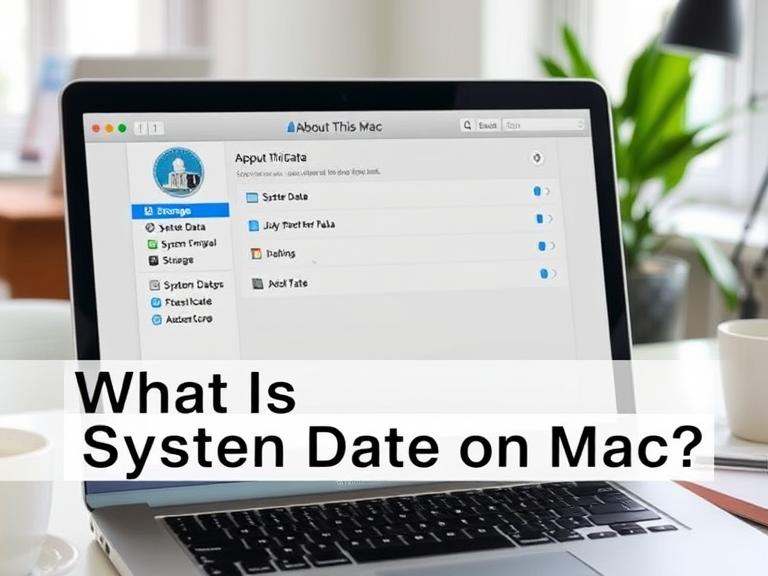What Is System Data on Mac? If you’ve checked your Mac’s storage and noticed a large “System Data” category taking up space, you’re not alone. This mysterious storage category confuses many users, leaving them wondering what it contains and whether it’s safe to remove.
This comprehensive guide will explain everything you need to know about System Data on Mac, including what it is, why it grows large, and how to manage it effectively.
Table of Contents
What Is System Data on Mac?
System Data (labeled as “Other Storage” in older macOS versions) is a catch-all category that includes essential system files and temporary data that don’t fit into standard categories like Applications, Documents, or Photos.
What’s Included in System Data?
- System Files and Resources
- macOS system components
- Fonts, plugins, and extensions
- Disk images (.dmg files) and installers
- Cache Files
- App caches (browsers, creative software)
- System caches (logs, temporary files)
- Virtual Machine Files
- Docker containers
- Parallels/VirtualBox virtual disks
- Time Machine Local Backups
- Snapshots not yet copied to external drive
- Mail Attachments & Downloads
- Email downloads not categorized elsewhere
- Unrecognized File Types
- Files macOS can’t classify
Why Is My System Data So Large? (Common Causes)
| Cause | Typical Size Impact |
|---|---|
| Time Machine snapshots | 10-50GB |
| App caches (especially creative apps) | 5-20GB |
| Old iOS backups | 5-15GB |
| Mail downloads | 1-10GB |
| Virtual machine files | 10GB+ |
| System logs | 1-5GB |
*Note: 100GB+ System Data usually indicates unmanaged backups or VM files*
How to Check System Data on Your Mac
Step-by-Step:
- Click Apple logo → About This Mac
- Go to Storage tab
- Wait for color-coded breakdown to load
- Hover over System Data for size details
Alternative: Use Disk Utility → Select Macintosh HD → Click “Info”
How to Reduce System Data (Safe Methods)
1. Clean Time Machine Snapshots
bash
sudo tmutil thinlocalsnapshots / 9999999999999999 1
2. Clear App Caches
- Manual: ~/Library/Caches → Delete contents
- App: CleanMyMac X (safest GUI option)
3. Purge System Logs
bash
sudo rm -rf /private/var/log/*
4. Remove Old iOS Backups
- Open Finder → Locations → Manage Backups
- Delete outdated device backups
5. Find Large Hidden Files
bash
sudo du -sh /* | sort -h
What NOT to Delete from System Data
❌ /System folder contents
❌ /usr directory files
❌ Kernel extensions
❌ Any file you don’t recognize
Warning: Deleting wrong system files can break macOS
Advanced: Reclaiming System Data Space
For Technical Users:
- Audit launch agentsbashlaunchctl list | grep -v apple
- Check for APFS snapshotsbashtmutil listlocalsnapshots /
- Inspect VM filesbashfind ~ -type f -size +1G
FAQs About Mac System Data
1. Is System Data safe to delete?
Partially – only user-created caches/backups should be removed manually
2. Why does System Data grow after updates?
Installer packages and recovery partitions temporarily expand it
3. Can malware hide in System Data?
Yes, but requires admin privileges to modify system areas
4. How often should I clean System Data?
Every 3-6 months for average users; monthly for creatives
5. Will resetting macOS reduce System Data?
Yes, but backup important files first
6. Does iCloud affect System Data size?
Only if storing incomplete uploads
7. Why doesn’t Disk Utility show System Data?
It’s categorized differently – use Storage Management instead
When to Worry About System Data
Normal:
- 15-30GB on most systems
- Fluctuates with usage
Concerning:
- Consistently over 100GB
- Rapid growth without new apps/files
- Accompanied by system slowdowns
Pro Tip: If System Data exceeds 50% of free space, investigate immediately
Best Practices for Managing System Data
- Monthly Maintenance
- Clear browser caches
- Review Downloads folder
- Annual Deep Clean
- Audit VM files
- Verify backup integrity
- Monitoring Tools
- DaisyDisk (visual file explorer)
- OmniDiskSweeper (detailed analysis)
Conclusion: System Data Demystified
While macOS labels these files mysteriously, System Data primarily consists of:
- Essential but non-critical system files
- Temporary working data
- User-generated cache files
For most users, occasional cleaning of caches and old backups keeps System Data at reasonable levels. Power users should monitor VM files and local snapshots more closely.
Remember: When in doubt about deleting system files, consult Apple Support or a Mac technician rather than risking system instability.

